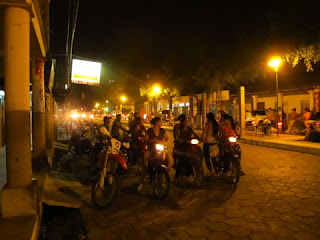it's an odd sort of thing - in the last week we've separately met two
very kind and very passionate Americans - both Christians, working and
living in Bolivia over the past 15 years or so. Stewart and his Bolivian
wife, Naide stopped and spoke to us on the road from Trinidad, and
subsequently invited us to stay with them; and Ronnie approached us when
we arrived in Rurrenabaque and helped us find a bike friendly hotel.
We've also seen quite a few Mormons and also Mennonites (close to the
Amish) walking around in their hats, overalls, women in long skirts and
matching striped shopping bags.
I've not yet worked out the appeal - or the reason why in the previous 8
months I've not met anyone like this - yet bang, since being near the
old Jesuit Missions and into the tropics of the jungle, meeting and
seeing so many. It has definitely been interesting listening to the many
stories, theories and religious ideas and experiences, but somehow
tiring as well (usually there's hours of listening involved). It's
interesting to see the different degrees of integration; for instance
Stewart doesn't speak much Spanish - despite Naide not speaking any
English, or the types of food eaten - from eating a typical amuerzo
(lunch) with Ronnie, to the hotcakes with syrup and bacon for a dinner
snack cooked by Naide.
 |
| 1 200cc bike, 5 people, 50kms of muddy road. RESPECt |
 |
| Road had turned to mud on the way back |
 |
| Road there - driving at night not so fun |
Stewart and Naide's place was a bit of a ways from the town we planned
on staying in - try 7 hours riding sand (which turned to mud on the way
back after rains) to get about 130kms. (thankfully i rode 2 up on the
sidecar) They don't see too many foreigners; apart from family who
visited we were the only English speakers that had come by in the past
year. The community near their house consisted about 20 families; no
electricity, a clean water tank was just being installed, every dirt
house was shared by the greater family, oxen pulling around carts,
cattle and pigs roaming around - and during rainy season it becomes
completely cut off and inaccessible by car. A very different way of life.
 |
| Stewart getting comfortable watching for hochi's |
 |
| Listening intently - he also played the mandolin quite well |
Stewart definitely had a luxurious house by comparison - his own water
tank/well/pump with a good pressure outdoor cold shower, 2 generators,
fridge and... air conditioners for 3 rooms. I can relate to this -
things we take as important - ie. clean drinking water, having a
sanitation tank for human waste etc are a bit out of the norm here.
 |
| A noisy friend |
We spent 5 days with them - Stewart was definitely a very strong
character; from Florida but with a strong southern accent, so his
stories about slow trail deer hunting, fishing using airboats, the frog
leg trade, stories of his brother, when he arrived in Bolivia, the
conversations he has with the Lord and miracles he has witnessed, were
told in an expressive slow drawl and with whole body passion. There were
some rather very strong views that came out but he was very welcoming,
and I learnt many new things about how people live out their beliefs.
 |
| Dancing in San Ignacio de Moxos |
 |
| Blocking the blockade |
 |
| Imagine this after 4 months of rainy season..... |
After 5 days we headed back to San Ignacio de Moxos, then to San Borja,
and yesterday a long day of riding to Rurrenabaque. On the way we
stopped for 2 hours at a road blockade that was in protest of a new road
being built through some protected areas to facilitate transport between
Chile and Brazil. A bit baking in the midday sun and I'm not sure if
there are more effective ways to find a solution. From there we went
through some muddy patches and road under construction to reach Rurre -
I cannot imagine how these roads are in the rainy season - we are now at
the end of the dry season and it's already difficult now.
Rurre for a couple of days, perhaps a venture out to Rio Tuichi to
hopefully see some animals, then got to work out how exactly I'm going
to get to Cusco to see mum and dad... there's a road on the map - but
apparently it doesn't exist... hmm....











































